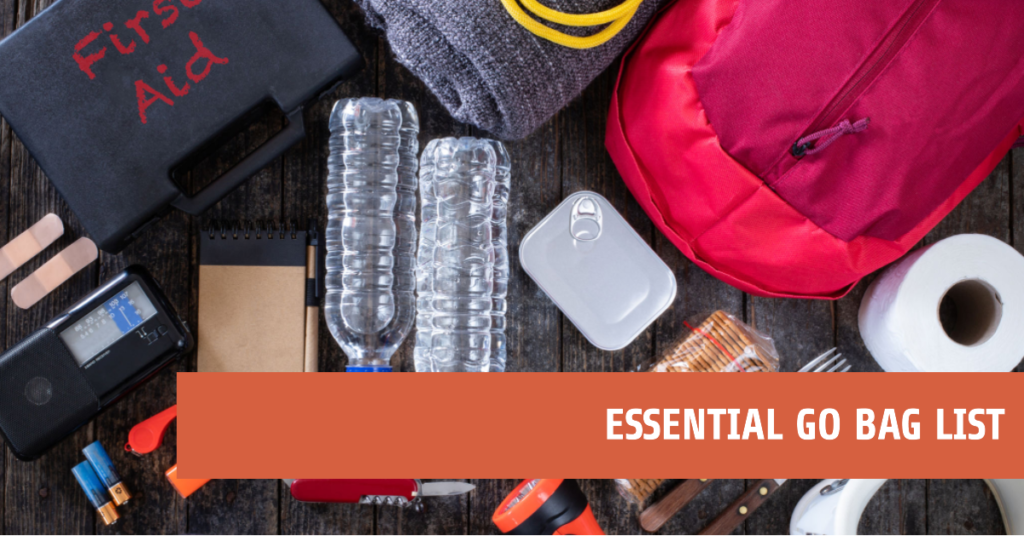
Our essential go bag list has you covered for emergencies at any skill level. Remember, tailor your go bag to your needs, location, and climate. Consider your specific emergency scenarios, too. With the right mix of items and foresight, you’ll be ready for any situation.
Essential Go Bag Checklist
- Water (bottled or hydration system): Crucial for hydration and cooking, aim for a minimum of 3 liters per person per day.
- Non-perishable food (energy bars, freeze-dried meals): Provides the energy needed to survive, choose calorie-dense and lightweight options.
- First aid kit: Basic medical supplies to treat minor injuries and illnesses, such as band-aids, gauze, and pain relievers.
- Multi-tool or knife: Versatile tool for cutting, opening cans, and other tasks, can be life-saving in various situations.
- Flashlight with extra batteries: Essential for visibility in low-light conditions, choose a durable, water-resistant model.
- Emergency whistle: Aids in signaling for help, especially when voice may not carry far enough.
- Local maps and a compass: Navigate unfamiliar terrain, even without electronic devices or cell service.
- Emergency shelter (emergency blanket, lightweight tarp): Provides protection from the elements in case of unplanned overnight stays.
- Fire starter (matches, lighter, or ferrocerium rod): Enables fire-making for warmth, cooking, and signaling.
- Portable water filter or purification tablets: Ensures access to safe drinking water by removing pathogens and impurities.
- Extra clothing (change of socks, hat, gloves): Helps maintain body temperature and prevent hypothermia, especially in wet or cold conditions.
- Personal hygiene items (toothbrush, toothpaste, toilet paper, hand sanitizer): Maintains cleanliness and prevents illness.
- Important documents (copies of ID, insurance, emergency contacts): Facilitates identification and access to essential services during emergencies.
- Rain poncho: Lightweight, compact, and waterproof, it provides protection from rain and can double as a makeshift shelter.
- Work gloves: Protect hands from blisters, cuts, and burns while performing tasks like chopping wood or handling tools.
- Portable solar charger: Provides an eco-friendly power source for devices, ensuring they remain functional during emergencies.
- Notepad and pen: Useful for taking notes, recording important information, or leaving messages for others.
- Emergency radio: Allows you to receive critical weather and disaster updates, ensuring you stay informed about your surroundings.
Advanced
- Paracord or rope: Useful for shelter building, gear repair, and various survival tasks.
- Compact cooking system (portable stove, fuel, cookware): Allows for hot meal preparation, which can boost morale and provide additional energy.
- Signaling mirror: Can signal rescuers from long distances by reflecting sunlight, especially useful in wilderness scenarios.
- Two-way radio or satellite communicator: Enhances communication with others and provides a method of calling for help.
- Insect repellent: Protects against insect-borne diseases and improves comfort in bug-infested areas.
- Duct tape: A versatile repair item for gear, clothing, and shelter.
- Sewing kit: Allows for repairs to clothing, gear, and even medical stitching if necessary.
- Spare eyeglasses or contact lenses: Ensures clear vision if primary eyewear is lost or damaged.
- Spare cash and small denominations of local currency: Useful for purchasing supplies or services during emergencies.
- Multiband emergency weather radio: Receives critical weather updates and emergency alerts in affected areas.
- More comprehensive first aid supplies (splint, suture kit, tourniquet): Enhances medical capabilities for more severe injuries.
- Headlamp: Provides hands-free lighting for tasks in low-light conditions.
- Lightweight, collapsible shovel: Multi-functional tool for digging fire pits, sanitation trenches, or snow shelters.
Expert
- Advanced navigation tools (GPS device, topographic maps): Provides precise location information and helps navigate complex terrain.
- High-quality survival knife or hatchet: Ideal for heavy-duty tasks, such as processing wood for fire or shelter building.
- Hunting or fishing equipment (compact fishing kit, snare wire): Increases self-sufficiency by allowing procurement of food in the wild.
- Advanced shelter options (lightweight tent, hammock, bivy sack): Offers improved comfort and protection from the elements.
- High-capacity water filter or purifier: Allows for filtering larger quantities of water, suitable for groups or extended stays.
- Long-range communication devices (HAM radio, satellite phone): Enables communication
- Flare gun: Can signal for help over vast distances and during adverse weather conditions.
- Gas mask with filters: Provides protection from airborne contaminants, such as smoke, dust, or hazardous chemicals.
If you’re new or seasoned in doomsday prep, a well-stocked go bag is vital. Follow our guide, and you’ll have the ultimate bug-out bag for you and your loved ones. Stay safe and secure in any emergency. Happy prepping!
